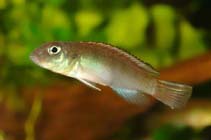
|
Nanochromis parilus Roberts & Stewart, 1976 |

|
|
photo by
Hippocampus-Bildarchiv |
| Family: | Cichlidae (Cichlids), subfamily: Pseudocrenilabrinae | |||
| Max. size: | 4.4 cm SL (male/unsexed) | |||
| Environment: | demersal; freshwater; pH range: 6 - 7; dH range: 5 - 8, | |||
| Distribution: | Africa: lower Congo River rapids in Democratic Republic of the Congo (Ref. 42510). | |||
| Diagnosis: | Diagnosis: upper half of caudal fin always with alternating pattern of black and white to yellow stripes; lower half of caudal fin variable in males: uniformly violet (pale and sometimes almost transparent) across entire fin, or with many rows of red spots, or any combination of both; females always with an unmarked, clear to pale violet lower half of the caudal fin (Ref. 52307). Description: males with elongated rays in dorsal, anal and pelvic fins, more so than females, and rays of upper portion of caudal fin may extend slightly, forming a small lappet; old males sometimes develop a small hump on their head (Ref. 52307). Coloration: body grayish-brown in upper half and more turquoise in lower half of both sexes; dorsal fin with black margin followed by a white submargin that is always broader in females than in males; ripe females with an often extremely swollen, violet belly (Ref. 52307). | |||
| Biology: | Found in large numbers in areas with slowly-flowing waters along the banks of the Congo River near Brazzaville and Kinshasa; does not seem to prefer the more rapidly-flowing parts of the river, even though Roberts & Stewart (1976) viewed it as a moderately rheophilic species (Ref. 52307). Feeds on worms, crustaceans and insects (Ref. 7020). Cave-spawner (Ref. 52307). | |||
| IUCN Red List Status: | Least Concern (LC); Date assessed: 16 February 2009 Ref. (130435) | |||
| Threat to humans: | harmless | |||